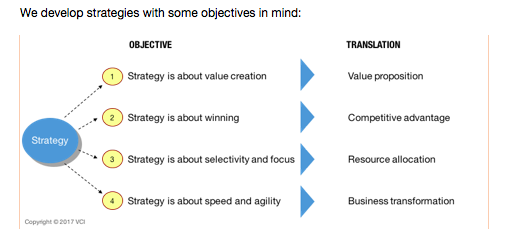By: Dave Harker, VCI Senior Consultant
Introduction
Blistering, high-speed, breakneck, dizzying, and lightning fast. These adjectives describe the pace of innovation in today’s business environment. Wise business leaders seek to apply digital technologies in ways that improve operations, reduce costs, and increase profits. Those with “shiny object syndrome” that pursue technology for technology’s sake are doomed to fail from the start. Meanwhile, visionary CEOs that strategize and establish linkages between digital technology and business outcomes are much more successful.
Here we present a case as to why CEOs need to devise and execute a digital strategy. Specifically, we assert that CEOs need a well thought out digital strategy for the following five reasons:
- Economic fundamentals are shifting
- Digital transformation produces economic benefits
- New and revamped business models present opportunities to grow revenue
- Companies with a clear digital advantage are more profitable than peers
- Failure to act exposes companies to threats from disruptors
Reason 1: Economic fundamentals are shifting
In general, the digital revolution has created more value for customers than it has for companies. In asset heavy industries like mining and oil & gas, this advantage has to shift to the management operating model. Participants have benefited from increased choice and availability of information. Meanwhile, companies are faced with shrinking profit margins as they have to lower prices in order to compete. Digital transformation has had the following effects:
- Lower transaction costs
- Greater number of choices available to customers
- Increased product information available to all
- Reduced need for distributors and intermediaries (middle-man)
Moreover, the competitive dynamics of today’s digital environment are putting profits in the hands of fewer and fewer companies. For example, the platform and scale that Amazon has built has enabled it to dominate retail and it has had a profound impact on other retailers. This is good for Amazon, whose stock price has soared over the last several years, and bad for its competitors. This week we saw the demise of Toys R Us as they are closing their 734 stores, putting 31,000 employees out of work and a debt to the vendor community of $30 Billion.

Reason 2: Digital transformation produces economic benefits
Despite shrinking profit margins, there is value and economic benefit to be captured from digital transformation. The below chart shows the projected economic benefit from various digital technologies to the mining and metals industry. The “connected worker” category is projected to generate $85 Billion in economic benefit between 2016 and 2025. This digital initiative would leverage the Internet of Things by employing wearables, sensors, and data analytics to connect workers and equipment with a central system. Remote operations centers are projected to be at $77 Billion and autonomous operations project to generate value of $55 Billion for the industry.

While the above chart projects economic benefit for the mining and metals industry as a whole, it should not be used as a short-cut to determine how to allocate investment dollars in digital technology. Each company and situation is unique and the allocation of budget and digital strategy depends on a myriad of factors.
Those industry CEOs who have an effective strategy and execute will capture the lion’s share of these projected economic benefits.
Reason 3: New and revamped business models present opportunities to grow revenue
DCP Midstream is a leading company in the natural gas industry and is the largest producer of Natural Gas Liquids (NGLs) in the U.S. The company has a sound digital strategy and is pushing to be a leader in the use of technology among its peer companies. DCP is committed to its digital strategy and transformation and is evaluating new business models that are made possible by innovative applications of technology. In fact, when DCP had its recent quarterly earnings call, the CEO showcased the company’s digital initiatives and stated that these initiatives have significant potential upside to cashflows. The USD 20MM investment that DCP put into digital projects in year one has already paid for itself. DCP expects to have a positive EBITDA benefit of USD 40MM in year two of the project. This economic benefit will be the result of lower costs and higher margins produced by the digital initiatives outlined in DCP’s strategy.

DCP Midstream engaged VCI to support and help architect its digital transformation roadmap to drive asset optimization, organization redesign and to reposition its business model.
Reason 4: Companies with a clear digital advantage are more profitable than peers
A study by MIT Sloan Management Review conducted found that the top 15% of digitally mature companies outperformed peers in key financial measures. The study labels this elite group as “Digirati”. The Digirati are described as having “executives that share a strong vision for what new technologies bring, invest in and mange digital technologies quickly and effectively, and gain the most value from digital transformation.” The chart below provides the comparison of digitally mature companies with less digitally mature companies. The results of the study show the Digirati or top 15% group had superior financial results in terms of revenue creation, profitability, and market valuation.

Reason 5: Failure to act exposes companies to threats from disruptors
In the 90’s, Harvard Business School professor, Clayton Christensen, coined the phrase “disruptive innovation.” According to Christensen, disruptive innovation usually involves a smaller company with fewer resources that is able to successfully challenge a larger established player in the industry. The challenger does this by taking an existing technology or service and developing a way to significantly drive down costs. Most of the time the technology isn’t state-of-the-art but because of the lower price point the disruptor is able to target a part of the market that was previously underserved. Little by little, the disruptor steals away market share from the larger more established players. Once they gain momentum, smart disruptors improve their products and drive upmarket.
An example of this type of disruption is provided by Elon Musk’s Space Exploration Technologies Corp or SpaceX. As a new entrant to the rocket ship industry, SpaceX drove down the cost of producing rockets and has been able to manufacture them at a fraction of the cost of its competitors (Boeing, Lockheed Martin and others). SpaceX’s mission has been to make space exploration more affordable and it has successfully taken away valuable contracts from incumbents.

VCI’s Track Record
VCI is uniquely positioned to support companies in the asset heavy industries and services industry with digital strategy. We have an enviable track record of successful projects in strategy and transformation. Among our accomplishments:
- VCI’s scenario strategy catalyzed rapid expansion and pioneered the move to remote operations and full automation in Australian bulk mining
- VCI designed and led the mining industry’s largest open innovation consortium in South Africa
- VCI developed the strategy for the world’s leading digital mine, including the creation of a new technology business start-up model
- VCI co-founded the first cloud-based forecasting and decision optimization engine for agriculture, mining and chemicals in Silicon Valley
- VCI started and operates the world’s pre-eminent think tank on strategy and innovation in the mining industry: State of Play™
The VCI Approach to Digital Transformation
From design to implementation, VCI focuses on the following four activities to ensure a successful digital transformation.
- We examine the use of technology in your organization. VCI’s Digital Intensity Assessment is designed to uncover the elements of digital maturity within the organization and provide actionable insights to company leaders. Combining the assessment with a battery of interviews and site inspection(s) VCI consultants paint an accurate picture of the present digital state at the company.
- We determine how value is generated by accelerating digitization. VCI consultants are trained to look holistically at the organization and use “systems thinking” to diagnose the fit and alignment of people, process, and technology in the service of a unifying strategy.
- We calculate the value of each possible opportunity. The levers and drivers are identified that provide digital sources of value. VCI consultants use quantitative and qualitative methods to calculate the potential economic benefit of key options and scenarios.
- We build a business case and implementation roadmap for your business. VCI consultants tie people, process, and technology to the company’s operating model and advise on culture and change management.




